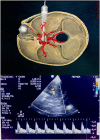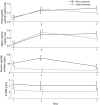Transcranial Doppler during the first week after cardiac arrest and association with 6-month outcomes
- PMID: 37859655
- PMCID: PMC10582351
- DOI: 10.3389/fneur.2023.1222401
Transcranial Doppler during the first week after cardiac arrest and association with 6-month outcomes
Abstract
Background: Early prediction of outcomes in comatose patients after out-of-hospital cardiac arrest is challenging. Prognostication tools include clinical examination, biomarkers, and neuroradiological and neurophysiological tests. We studied the association between transcranial Doppler (TCD) and the outcome.
Methods: This was a pre-defined sub-study of the prospective observational Norwegian Cardiorespiratory Arrest Study. Patients underwent standardized post-resuscitation care, including target temperature management (TTM) to 33°C for 24 h. TCD was performed at days 1, 3, and 5-7. The primary endpoint was cerebral performance category (CPC) at 6 months, dichotomized into good (CPC 1-2) and poor (CPC 3-5) outcomes. We used linear mixed modeling time-series analysis.
Results: Of 139 TCD-examined patients, 81 (58%) had good outcomes. Peak systolic velocity in the middle cerebral artery (PSV) was low during TTM (Day 1) and elevated after rewarming (Day 3). Thereafter, it continued to rise in patients with poor, but normalized in patients with good, outcomes. At days 5-7, PSV was 1.0 m/s (95% CI 0.9; 1.0) in patients with good outcomes and 1.3 m/s (95% CI 1.1; 1.4) in patients with poor outcomes (p < 0.001).
Conclusion: Elevated PSV at days 5-7 indicated poor outcomes. Our findings suggest that serial TCD examinations during the first week after cardiorespiratory arrest may improve our understanding of serious brain injury.
Keywords: brain; brain damage; cardiac arrest (CA); heart; out of hospital arrest; ultrasound.
Copyright © 2023 Reichenbach, Alteheld, Henriksen, Nakstad, Andersen, Sunde, Šaltytė Benth and Lundqvist.
Conflict of interest statement
The authors declare that the research was conducted in the absence of any commercial or financial relationships that could be construed as a potential conflict of interest.
Figures




References
-
- Grasner JT, Lefering R, Koster RW, Masterson S, Bottiger BW, Herlitz J, et al. . EuReCa ONE-27 Nations, ONE Europe, ONE registry: a prospective one month analysis of out-of-hospital cardiac arrest outcomes in 27 countries in Europe. Resuscitation. (2016) 105:188–95. 10.1016/j.resuscitation.2016.10.001 - DOI - PubMed
LinkOut - more resources
Full Text Sources

